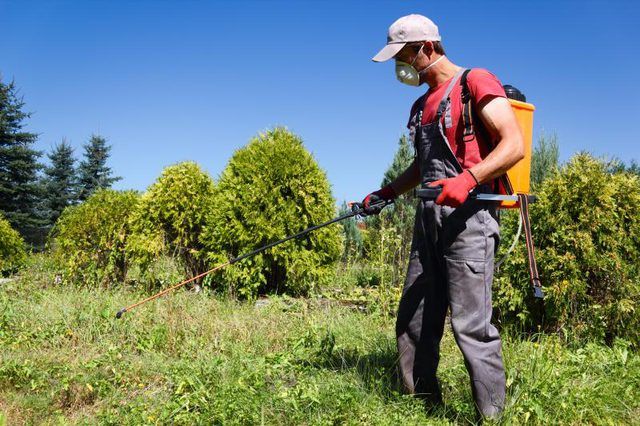Bulbs
Flower Basics
Flower Beds & Specialty Gardens
Flower Garden
Garden Furniture
Garden Gnomes
Garden Seeds
Garden Sheds
Garden Statues
Garden Tools & Supplies
Gardening Basics
Green & Organic
Groundcovers & Vines
Growing Annuals
Growing Basil
Growing Beans
Growing Berries
Growing Blueberries
Growing Cactus
Growing Corn
Growing Cotton
Growing Edibles
Growing Flowers
Growing Garlic
Growing Grapes
Growing Grass
Growing Herbs
Growing Jasmine
Growing Mint
Growing Mushrooms
Orchids
Growing Peanuts
Growing Perennials
Growing Plants
Growing Rosemary
Growing Roses
Growing Strawberries
Growing Sunflowers
Growing Thyme
Growing Tomatoes
Growing Tulips
Growing Vegetables
Herb Basics
Herb Garden
Indoor Growing
Landscaping Basics
Landscaping Patios
Landscaping Plants
Landscaping Shrubs
Landscaping Trees
Landscaping Walks & Pathways
Lawn Basics
Lawn Maintenance
Lawn Mowers
Lawn Ornaments
Lawn Planting
Lawn Tools
Outdoor Growing
Overall Landscape Planning
Pests, Weeds & Problems
Plant Basics
Rock Garden
Rose Garden
Shrubs
Soil
Specialty Gardens
Trees
Vegetable Garden
Yard Maintenance
How to Get Rid of a Bee's Nest in the Ground
How to Get Rid of a Bee's Nest in the Ground. One of life’s more unpleasant experiences is discovering that your lawn or garden has an underground nest of social bees or wasps. The nest is often discovered when a homeowner accidentally disturbs it while mowing the lawn or weeding the garden and the stinging insects come swarming out of the...
One of lifeís more unpleasant experiences is discovering that your lawn or garden has an underground nest of social bees or wasps. The nest is often discovered when a homeowner accidentally disturbs it while mowing the lawn or weeding the garden and the stinging insects come swarming out of the ground to defend their nest. Yellowjackets are the most dangerous social ground nesters, and are not only able to sting more than once, but will pursue and continue to sting a perceived threat. If you are allergic to bee stings or the underground nest is large, it's probably best and safest to call a professional to handle the problem. Keep children and pets away from the area until the nest is treated and the insects are no longer a threat.
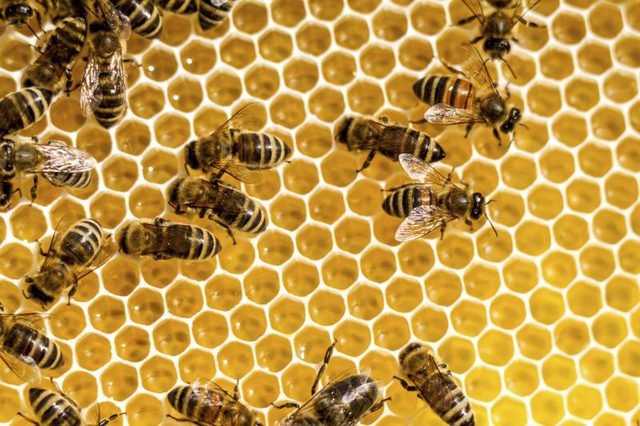
Yellowjackets, or Vespula maculifrons, are not pollinators or nectar drinkers. They are predatory wasps that feed on other insects and on human foods like meats and fruit. Often called "meat bees," they are really not bees at all, but wasps. They are slim, smooth-skinned, banded with black and yellow and about a half-inch long. They live in concealed colonies -- either underground or in a handy opening in a wall or tree -- that can number 2,000 or more insects and aggressively defend their nests. Yellowjackets are quick to sting, even if they are on your turf, and not in their nest. Bumblebees, or Bombus terristris, are pollinators that feed on nectar and pollen. They live in underground colonies of 25 to 500 insects. They are heavy-bodied, black-and-yellow, fuzzy insects that can grow up to 3/4 of an inch long. Bumblebees look startling, but seldom sting when going about their business. They will defend their nests, however.
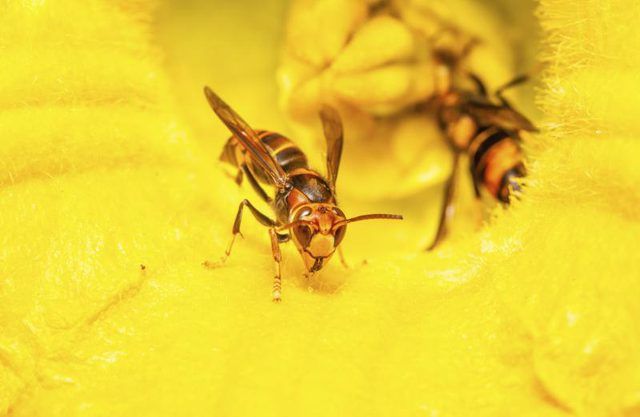
If you are going to attack a nest, dress appropriately. Wear heavy jeans, shoes and socks. A heavy duty rubber band around the ankles of your pants will prevent yellowjackets from crawling inside your clothes. Put on a hooded sweatshirt, veil and thick gloves. If applying chemicals, wear goggles to protect your eyes. Donít go after any stinging insect in sandals, tank tops or shorts. And make sure you have a clear escape path. Any insects that evade your attack will be out to get you, so donít make it too easy for them. If possible, place a marker by the underground nest before treating it so you can easily find it in the dark without using a flashlight. The insects are drawn to the light and are more prone to become agitated and drawn out of the nest.
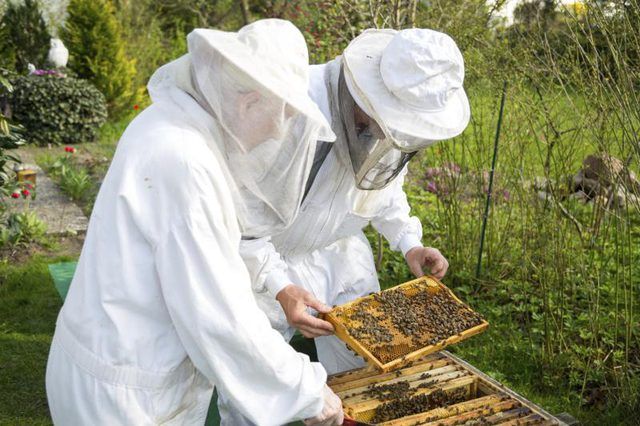
Boiling water is the most environmentally safe means for destroying small in-ground nests. For this option to work the nest must be located directly under the opening, as using this method on larger underground nests will not work because the product cannot reach the entire nest. Wait until the insects have settled in for the evening, then boil at least 8 cups of water, take the container to the nestís entrance hole and pour it in. Get away quickly. Repeat each evening until you don't see any more insect activity. The boiling water treatment works well in combination with a peppermint soap solution. Made it by combining 2 cups of peppermint-scented liquid soap, or dish soap with a few drops of peppermint oil concentrate, with 2 cups of hot water. Wait until sunset when the insects have settled in for the night. Make the soap mixture and pour it down the nestís entrance hole. Follow immediately with the 8 cups of plain boiling-hot water and get away. Repeat the next evening if insects are still active.
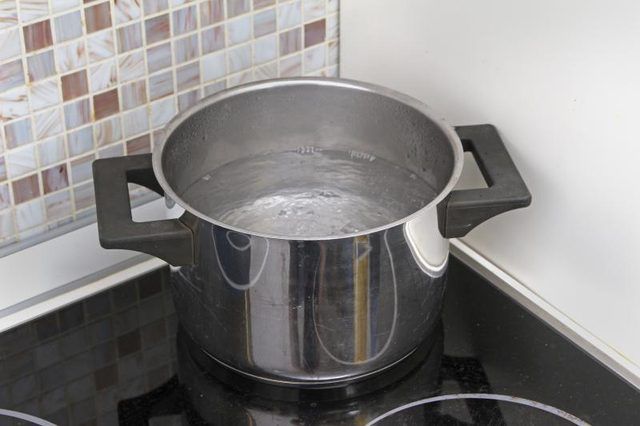
Commercial insecticide dusts like carbaryl are effective for destroying ground-nesting bees and wasps. If using a commercial bee and wasp dust, choose one intended for use on lawns or in soil. Wait for a period when no rain is forecast. Apply 1/4 cup of the dust in and around the nest opening at dusk, then leave the area. Approach the area in a calm manner, as the insects are attracted to quick-moving objects. As the insects go in and out, they'll pick up the deadly dust on their bodies and carry it to all parts of the nest. Repeat the treatment for a second or third evening if you see continued insect activity. Donít seal the nest opening until you are sure all the insects are dead. If any are alive in the nest, they will dig a new opening and rebuild the colony.
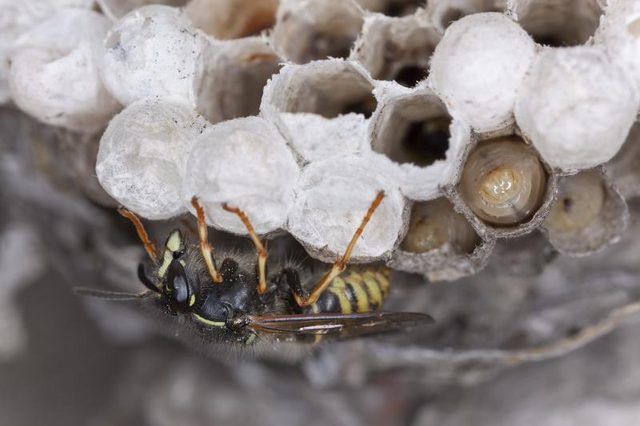
Most bees and wasps rely on light to let them know it's time for work, and tend to think they are outside if they can see light. You can trap them in place if there's enough light to make them think they're outside. Wait until evening or night to place a large clear, clean glass bowl tightly over the nest entrance hole. Because the clear bowl lets sunshine in, the insects won't realize they are trapped so they won't try to dig another exit. They should starve within a few days.
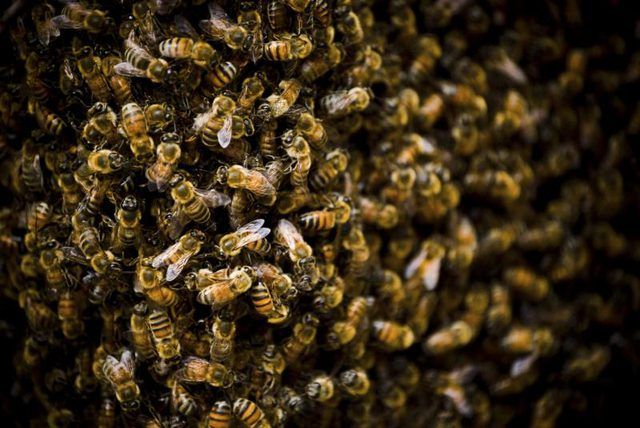
Commercial wasp-killer sprays shoot a stream approximately 20 feet, so you don't have to stand directly over the underground nest. Dress appropriately in the event the insects come out of the nest when they sense the pesticide and wear goggles to keep the product from accidentally getting into your eyes. Once it becomes dark and the nest is less active, spray the product directly into the underground opening and quickly move away. If the nest is large, the product may not fully saturate the entire area and may require a repeat application.
